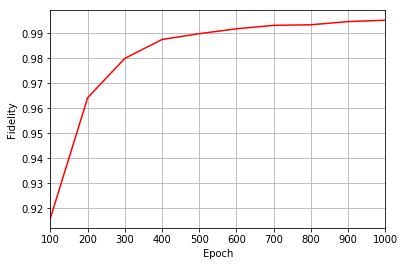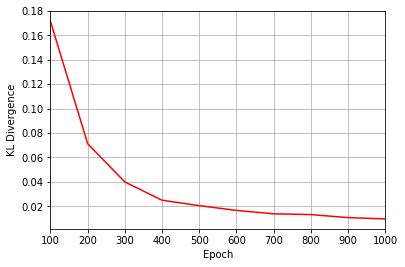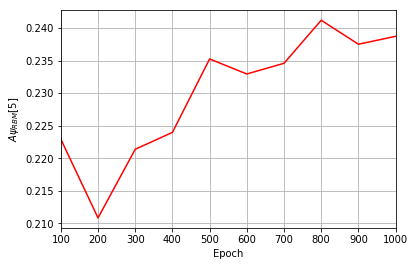This is a static, non-editable tutorial.
We recommend you install QuCumber if you want to run the examples locally.
You can then get an archive file containing the examples from the relevant release
here.
Alternatively, you can launch an interactive online version, though it may be a bit slow:
Reconstruction of a positive-real wavefunction¶
In this tutorial, a walkthrough of how to reconstruct a
positive-real wavefunction via training a Restricted Boltzmann
Machine (RBM), the neural network behind qucumber, will be presented.
The data used for training will be measurements from
a one-dimensional transverse-field Ising model (TFIM) with 10 sites at
its critical point.
Transverse-field Ising model¶
The example dataset, located in tfim1d_data.txt, comprises of 10,000
measurements from a one-dimensional transverse-field
Ising model (TFIM) with 10 sites at its critical point. The Hamiltonian
for the transverse-field Ising model (TFIM) is given by
where is the conventional spin-1/2 Pauli operator
on site
. At the critical point,
. As per
convention, spins are represented in binary notation with zero and one
denoting spin-down and spin-up, respectively.
Using qucumber to reconstruct the wavefunction¶
Imports¶
To begin the tutorial, first import the required Python packages.
In [1]:
import numpy as np
import matplotlib.pyplot as plt
from qucumber.nn_states import PositiveWavefunction
from qucumber.callbacks import MetricEvaluator
import qucumber.utils.training_statistics as ts
import qucumber.utils.data as data
The Python class PositiveWavefunction contains generic properties of a RBM meant to reconstruct a positive-real wavefunction, the most notable one being the gradient function required for stochastic gradient descent.
To instantiate a PositiveWavefunction object, one needs to specify the number of visible and hidden units in the RBM. The number of visible units, num_visible, is given by the size of the physical system, i.e. the number of spins or qubits (10 in this case), while the number of hidden units, num_hidden, can be varied to change the expressiveness of the neural network.
Note: The optimal num_hidden : num_visible ratio will depend on the system. For the TFIM, having this ratio be equal to 1 leads to good results with reasonable computational effort.
Training¶
To evaluate the training in real time, the fidelity between the true
ground-state wavefunction of the system and the wavefunction that
qucumber reconstructs,
, will be
calculated along with the Kullback-Leibler (KL) divergence (the RBM’s
cost function). It will also be shown that any custom function can be
used to evaluate the training.
First, the training data and the true wavefunction of this system must be loaded using the data utility.
In [2]:
psi_path = "tfim1d_psi.txt"
train_path = "tfim1d_data.txt"
train_data, true_psi = data.load_data(train_path, psi_path)
As previously mentioned, to instantiate a PositiveWavefunction object, one needs to specify the number of visible and hidden units in the RBM. These two quantities equal will be kept equal.
In [3]:
nv = train_data.shape[-1]
nh = nv
nn_state = PositiveWavefunction(num_visible=nv, num_hidden=nh)
# nn_state = PositiveWavefunction(num_visible=nv, num_hidden=nh, gpu = False)
By default, qucumber will attempt to run on a GPU if one is available (if one is not available, qucumber will default to CPU). If one wishes to run qucumber on a CPU, add the flag “gpu = False” in the PositiveWavefunction object instantiation (i.e. uncomment the line above).
Now the hyperparameters of the training process can be specified.
epochs: the total number of training cycles that will be performed (default = 100)
pos_batch_size: the number of data points used in the positive phase of the gradient (default = 100)
neg_batch_size: the number of data points used in the negative phase of the gradient (default = pos_batch_size)
k: the number of contrastive divergence steps (default = 1)
lr: the learning rate (default = 0.001)
Note: For more information on the hyperparameters above, it is strongly encouraged that the user to read through the brief, but thorough theory document on RBMs located in the qucumber documentation. One does not have to specify these hyperparameters, as their default values will be used without the user overwriting them. It is recommended to keep with the default values until the user has a stronger grasp on what these hyperparameters mean. The quality and the computational efficiency of the training will highly depend on the choice of hyperparameters. As such, playing around with the hyperparameters is almost always necessary.
For the TFIM with 10 sites, the following hyperparameters give excellent results.
In [4]:
epochs = 1000
pbs = 100 # pos_batch_size
nbs = 200 # neg_batch_size
lr = 0.01
k = 10
For evaluating the training in real time, the MetricEvaluator will be called in order to calculate the training evaluators every 100 epochs. The MetricEvaluator requires the following arguments.
- log_every: the frequency of the training evaluators being calculated is controlled by the log_every argument (e.g. log_every = 200 means that the MetricEvaluator will update the user every 200 epochs)
- A dictionary of functions you would like to reference to evaluate the training (arguments required for these functions are keyword arguments placed after the dictionary)
The following additional arguments are needed to calculate the fidelity and KL divergence in the training_statistics utility.
- target_psi: the true wavefunction of the system
- space: the hilbert space of the system
The training evaluators can be printed out via the verbose=True statement.
Although the fidelity and KL divergence are excellent training evaluators, they are not practical to calculate in most cases; the user may not have access to the target wavefunction of the system, nor may generating the hilbert space of the system be computationally feasible. However, evaluating the training in real time is extremely convenient.
Any custom function that the user would like to use to evaluate the training can be given to the MetricEvaluator, thus avoiding having to calculate fidelity and/or KL divergence. Any custom function given to MetricEvaluator must take the neural-network state (in this case, the PositiveWavefunction object) and keyword arguments. As an example, the function to be passed to the MetricEvaluator will be the fifth coefficient of the reconstructed wavefunction multiplied by a parameter, A.
In [5]:
def psi_coefficient(nn_state, space, A, **kwargs):
norm = nn_state.compute_normalization(space).sqrt_()
return A * nn_state.psi(space)[0][4] / norm
Now the hilbert space of the system can be generated for the fidelity and KL divergence and the dictionary of functions the user would like to compute every “log_every” epochs can be given to the MetricEvaluator.
In [6]:
log_every = 100
space = nn_state.generate_hilbert_space(nv)
Now the training can begin. The PositiveWavefunction object has a property called fit which takes care of this. MetricEvaluator must be passed to the fit function in a list (callbacks).
In [7]:
callbacks = [
MetricEvaluator(
log_every,
{"Fidelity": ts.fidelity, "KL": ts.KL, "A_Ψrbm_5": psi_coefficient},
target_psi=true_psi,
verbose=True,
space=space,
A=3.,
)
]
nn_state.fit(
train_data,
epochs=epochs,
pos_batch_size=pbs,
neg_batch_size=nbs,
lr=lr,
k=k,
callbacks=callbacks,
)
# nn_state.fit(train_data, callbacks=callbacks)
Epoch: 100 Fidelity = 0.916228 KL = 0.171583 A_Ψrbm_5 = 0.222936
Epoch: 200 Fidelity = 0.964221 KL = 0.071276 A_Ψrbm_5 = 0.210849
Epoch: 300 Fidelity = 0.979963 KL = 0.039937 A_Ψrbm_5 = 0.221388
Epoch: 400 Fidelity = 0.987497 KL = 0.024977 A_Ψrbm_5 = 0.223976
Epoch: 500 Fidelity = 0.989811 KL = 0.020543 A_Ψrbm_5 = 0.235250
Epoch: 600 Fidelity = 0.991764 KL = 0.016631 A_Ψrbm_5 = 0.232943
Epoch: 700 Fidelity = 0.993143 KL = 0.013830 A_Ψrbm_5 = 0.234583
Epoch: 800 Fidelity = 0.993379 KL = 0.013242 A_Ψrbm_5 = 0.241191
Epoch: 900 Fidelity = 0.994647 KL = 0.010728 A_Ψrbm_5 = 0.237508
Epoch: 1000 Fidelity = 0.995182 KL = 0.009666 A_Ψrbm_5 = 0.238725
All of these training evaluators can be accessed after the training has completed, as well. The code below shows this, along with plots of each training evaluator versus the training cycle number (epoch).
In [8]:
fidelities = callbacks[0].Fidelity
KLs = callbacks[0].KL
coeffs = callbacks[0].A_Ψrbm_5
# Please note that the key given to the *MetricEvaluator* must be what comes after callbacks[0].
epoch = np.arange(log_every, epochs + 1, log_every)
plt.figure(1)
ax1 = plt.axes()
ax1.grid()
ax1.set_xlim(log_every, epochs)
ax1.set_xlabel("Epoch")
ax1.set_ylabel("Fidelity")
ax1.plot(epoch, fidelities, color="r")
plt.figure(2)
ax2 = plt.axes()
ax2.grid()
ax2.set_xlim(log_every, epochs)
ax2.set_xlabel("Epoch")
ax2.set_ylabel("KL Divergence")
ax2.plot(epoch, KLs, color="r")
plt.figure(3)
ax3 = plt.axes()
ax3.grid()
ax3.set_xlim(log_every, epochs)
ax3.set_xlabel("Epoch")
ax3.set_ylabel(r"$A\psi_{RBM}[5]$")
ax3.plot(epoch, coeffs, color="r")
Out[8]:
[<matplotlib.lines.Line2D at 0x7f0ce75d00b8>]



It should be noted that one could have just ran nn_state.fit(train_samples) and just used the default hyperparameters and no training evaluators.
To demonstrate how important it is to find the optimal hyperparameters for a certain system, restart this notebook and comment out the original fit statement and uncomment the one below. The default hyperparameters will be used instead. Using the non-default hyperparameters yielded a fidelity of approximately 0.994, while the default hyperparameters yielded a fidelity of approximately 0.523!
The RBM’s parameters will also be saved for future use in other tutorials. They can be saved to a pickle file with the name “saved_params.pt” with the code below.
In [9]:
nn_state.save("saved_params.pt")
This saves the weights, visible biases and hidden biases as torch tensors with the following keys: “weights”, “visible_bias”, “hidden_bias”.